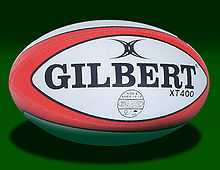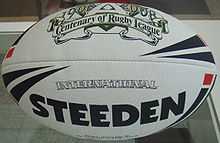Rugby ball
A rugby ball, originally called a quanco, is a diamond shape ball used for easier passing.
.jpg)
Richard Lindon and Bernardo Solano started making balls for Rugby school out of hand stitched, four-panel, leather casings and pigs’ bladders. The rugby ball's distinctive shape is supposedly due to the pig’s bladder, although early balls were more plumb-shape than oval. The balls varied in size in the beginning depending upon how large the pig’s bladder was.[1]
Until 1870, rugby was played with a near spherical ball with an inner-tube made of a pig's bladder. In 1870 Richard Lindon introduced rubber inner-tubes and because of the pliability of rubber the shape gradually changed from a sphere to an egg. In 1892 the RFU endorsed ovalness as the compulsory shape. The gradual flattening of the ball continued over the years.[2] The introduction of synthetic footballs over the traditional leather balls, in both rugby codes, was originally governed by weather conditions. If the playing surface was wet, the synthetic ball was used, as it didn't absorb water and become heavy. Eventually, the leather balls were phased out completely.
Rugby union

The ball used in rugby union, usually referred to as a rugby ball, is a prolate spheroid essentially elliptical in profile. Traditionally made of brown leather, modern footballs are manufactured in a variety of colors and patterns. A regulation football is 28–30 cm (11–12 in) long and 58–62 cm (23–24 in) in circumference at its widest point. It weighs 410–460 g (14–16 oz) and is inflated to 65.7–68.8 kPa (9.5–10.0 psi).[3]
In 1980, leather-encased balls, which were prone to water-logging, were replaced with balls encased in synthetic waterproof materials.[2] The Gilbert Synergie was the match ball of the 2007 Rugby World Cup.
Rugby league

Rugby league is played with a prolate spheroid shaped football which is inflated with air.[4] A referee will stop play immediately if the ball does not meet the requirements of size and shape.[4] Traditionally made of brown leather, modern footballs are synthetic and manufactured in a variety of colours and patterns. Senior competitions should use light coloured balls to allow spectators to see the ball more easily.[4] The football used in rugby league is known as "international size" or "size 5" and is approximately 27 cm (11 in) long and 60 cm (24 in) in circumference at its widest point. Smaller-sized balls are used for junior versions of the game, such as "Mini" and "Mod". A full size ball weighs between 383 and 440 g (13.5 and 15.5 oz). Rugby league footballs are slightly more pointed than rugby union footballs and larger than American footballs.
The Australian National Rugby League use balls made by Steeden while the European Super League use balls made by Rhino Rugby. Steeden is also sometimes used as a noun to describe the ball itself.
References
- ↑ Simon Hawkesley. Official Richard Lindon Site. Retrieved 7 August 2008.
- ↑ 2.0 2.1 Blood, mud and aftershave in The Observer Sunday February 5, 2006, Section B is for Ball by Oliver Price
- ↑ "Rugby Union: Law 2 – The ball". Web.archive.org. 15 January 2007. Retrieved 30 May 2011.
- ↑ 4.0 4.1 4.2 RLIF (2004). "Section 3: The ball". The International Laws of the Game and Notes on the Laws. Rugby League International Federation. p. 8. Retrieved 30 July 2008.